Robots Steal Show at Old Dominion University.
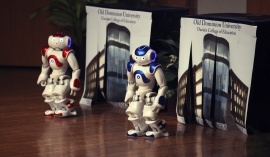
Congratulations to Old Dominion University that prepared an amazing show, that " broke down STEM barriers".
We know all the work required behind the scene ! The article explaining how the robots are used for STEM , is very inspiring and the actual video of the robot has a great touch. What an entrance. Keep on the great work you're doing with the robots Dr. Helen Crompton.
RobotsLAB Team
- 0 Comments
- Aug 27, 2015 7:59:00 PM
- Posted by Charles Nimrad
- Topics: STEM, NAO
Happy Pie Day math lovers
RobotsLAB wishes you a happy Pie Day . A very special one as mentioned in this great Slate article 3/14/15, and here you have the first 4 digits of Pi 3.1415 . Wait, the article continues and point out that at 9am or 9pm , you should wait for 26 min and 53 seconds. Look at your watch, your phone or your iwatch and you will see the first 10 digits of Pi 3.141592653 ... How cool is that? We math lovers, number admirers will be sure to catch that very moment.
And it's also Einstein's birthday..
Like every special day it is best to spend with beings you care about. You know who we're going to spend it with :)

- 0 Comments
- Mar 13, 2015 9:18:00 PM
- Posted by Charles Nimrad
- Topics:
Math joke
Fun education cartoon, Math meets jokes! We had a blog post earlier about Math meeting Arts, on a different level this cartoon can be Art and definitely meets Math.

- 0 Comments
- Mar 3, 2015 7:23:00 PM
- Posted by Charles Nimrad
- Topics:
NAO Robot Making his show in Mexico
This how it looks when our partner in Mexico is kick-ing off a show for EdTech to the local government !
- 0 Comments
- Nov 14, 2014 7:55:41 PM
- Posted by Charles Nimrad
- Topics:
RobotsLAB Announces STEM Teaching Aids Aligned With McGraw-Hill and Pearson Curricula at Kaplan EdTech Demo Day
RobotsLAB Announces STEM Teaching Aids Aligned With McGraw-Hill and Pearson Curricula at Kaplan EdTech Demo Day
RobotsLAB Shares Vision for Improving U.S. Math and Science Performance with Investors and Educators
San Francisco, CA ; New York, NY – October 22, 2014 – RobotsLAB, the educational robotics company™, today announced the 2015 version of the RobotsLAB BOX. RobotsLAB BOX is an innovative set of four robots and accompany lessons that aid teachers to demonstrate complex STEM subjects. The newest version of RobotsLAB BOX was announced today at TechStars EdTech Demo Day in front of hundreds leaders in education. In addition, the 2015 version of this award-winning kit is newly-aligned with the curricula and lesson plans of education market leaders such as McGraw-Hill and Pearson.
RobotsLAB sells revolutionary programs that use robots to bring abstract concept to life bridging abstract and concrete, making them easier to understand by students. The standards-aligned curricula uses flying drones to teach algebra and calculus, an intelligent basketball to demonstrate problems in algebra and statistics, as well other robots such as rovers, and a humanoid robot that drives his own car, covering a variety of STEM subjects.
According to recent reports, only thirty-two percent of U.S. high school students were proficient in math upon graduation even though sixty-two percent of U.S. jobs require entry-level workers to be proficient in algebra. RobotsLAB's mission is to solve this learning gap by using robots to create “Ah Ha!” moments in the classroom.
“We are excited to be working with Kaplan to accelerate the development of the company, expanding our reach, and our products development” said Elad Inbar, CEO of RobotsLAB.
The Kaplan EdTech Demo Day is organized to highlight leading startups focused on education. The product launch was attended by more than 500 stakeholders in the Edtech community, venture capitalists, and education industry leaders.
Already this year, RobotsLAB has continued its pattern of solid growth and ongoing innovation. Highlights from 2014 include:
• The introduction of four new products and accompanying curriculum
• Introduction of RobotsLAB BOX curriculum into Spanish
• Educational robots from RobotsLAB now in place in schools in every U.S. state
• RobotsLAB named the Edison Award Gold Winner for Innovation in Education
• RobotsLAB was the winner of the LAUNCHedu Competition at SXSWedu earlier in 2014
• RobotsLAB MathBall was awarded ISTE 2014 Best of Show
• RobotsLAB BOX awarded one of "Latest and Greatest #Education Friendly Tools" by Scholastic Administrator Magazine.
• RobotsLAB BOX received Reader's Choice Award from eSchool News
About RobotsLAB: Working in the intersection of robotics and education, RobotsLAB is introducing drones, rovers and other robots as a teaching-aid for middle and high school math and science classrooms. Many STEM projects focus mainly on the STE-, neglecting the M(ath) component. Meanwhile mathematics proficiency in high school students has fallen to 32% -- disqualifying many graduates from entry-level jobs. Our team of roboticists, engineers, teachers and professors are dedicated to fixing the education system using 21st century technology, bringing math to life and preparing students for their future. RobotsLAB’s mission is to augment educators and engage students using the most innovative tools -- driving excellence, and ensuring their future success. http://www.RobotsLAB.com
- 0 Comments
- Oct 22, 2014 4:06:00 PM
- Posted by Charles Nimrad
- Topics:
NAO robot is revolutionizing STEM
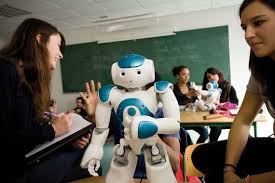
“Klaatu Barada Nikto,” that’s robot talk for...well, several things, including “don’t destroy the Earth” (I’m paraphrasing here, but that is a line from the 1950 Sci-Fi thriller, The Day the Earth Stood Still). It seems that GORT, a huge and immensely powerful robot has been brought to Earth to teach mankind a lesson; i.e., “either quit fighting among yourselves or I am going to get rid of you all before you become a danger to other planets.” And only moments before he teaches mankind that violent lesson, along comes Helen Benson, played by Patricia Neal, who utters the fail-safe phrase that began this paragraph and ends GORT’s rampage.
Fortunately, NAO, today’s premier teaching-robot, responds to English--as well as French, Japanese and most other languages. And while GORT had a bad attitude and stood fifty-plus feet tall, NAO stands less than four feet and is so unthreatening that he is welcomed as a friend and teacher by autistic children. NAO has one other advantage over GORT: there’s a lot more of them; in fact, NAO is by far the most popular robot for educational purposes.
In spite of NAO’s small size, he is of immense value to education. No STEM learning academy is more aware of that than techJOYnt in Oklahoma, City. In the movie, GORT pretty much stayed in one place while he decided what to do; NAO, part of techJOynt’s mobile STEM lab, teaches mankind all over Oklahoma City, from Rockwell Plaza to satellite campuses at Oklahoma City Community College. He is part of the techJOYnt’s Humanoid Robotics course. He helps students study Node and Python programming using touch and motion sensors; and as as mentioned earlier NAO also helps autistic students communicate.
One thing both GORT and NAO have in common is their ability to engage students. Kids love robots. Can’t keep their eyes or their hands off them. That’s why we at RobotsLAB are so pleased to partner with techJOYnt in seeking to put even more of them into schools.
GORT’s presence was enough to get an important lesson across to mankind (a lesson, I might add, that recent news indicates we didn’t learn very well). NAO’s presence is less imposing and the curriculum more varied. According to Ray Shaik, President and CEO of techJOYnT, “By using the NAO robot in class, students connect theory and practice, develop teamwork and communication skills, and gain a higher level of motivation and interest in technical career paths.” We earthlings have every reason to hope that the results will be more lasting.
- 0 Comments
- Aug 13, 2014 8:01:42 AM
- Posted by Charles Nimrad
- Topics: Robotics, STEM, Education, NAO
The best soccer player were playing in brazil last week
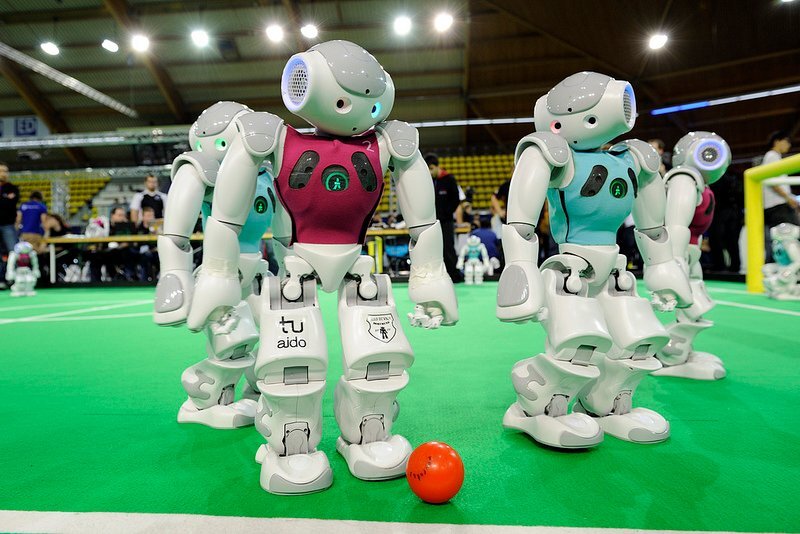
NAO, the small but mighty anthropomorphic robot manufactured by the French company Aldebaran, is evolving. Already the planet’s most acclaimed fully programmable, autonomous robot for education and research with over 5000 operating in more than seventy countries; NAO EVOLUTION, the new generation, sports several advancements over its successful predecessor.
- 0 Comments
- Aug 8, 2014 12:38:00 PM
- Posted by Charles Nimrad
- Topics: NAO
Can video games teach math?
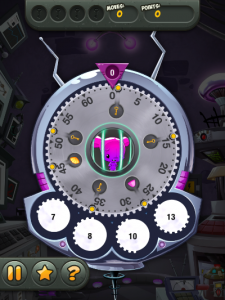
Dr. Keith Devlin (the NPR Math Guy and Stanford Mathematician) believes that anyone can become proficient in math if it is taught in a way that makes it relevant to them, and a perfect way to teach math to middle-school kids is with video games. He’s putting his money where his mouth is by starting his own video game company, InnerTube Games. According to InnerTube Games, the company doesn’t just build video games to teach mathematics, instead they build ‘instruments’ which are designed to be played; and playing with these instruments teaches the players mathematics. A bit like learning about music while playing the piano.
Wuzzit Trouble, the first game developed by InnerTube games, came out late last year. Wuzzits are imaginary little beings that look like tailless squirrels with a proclivity for getting trapped in cages in dark castles. It’s up to the player to get them out of these cages with keys found by answering puzzles. That’s one level of the game. At another level the game is a device for acquainting kids with the mathematical concept of integer partitions. Integer partitions are whole numbers expressed as a sum of other whole numbers. The whole number 4, for example can be expressed in five different ways: 4, 2+2, 3+1, 2+1+1 and 1+1+1+1.
- 0 Comments
- Aug 4, 2014 12:00:00 PM
- Posted by Charles Nimrad
- Topics: 21st Century Classroom
Summer slide achievement gap vacation
This shouldn't come as a surprise, but after three months off in the summer most kids return in September at a lower learning level than when they departed: A whole month behind, according to Catherine Augustine a senior policy researcher at the RAND Corporation who has studied summer learning loss. Apparently a majority of children come back behind in math, whereas fewer are left behind in reading. This step backward is most obvious with children in low income neighborhoods where they might have less access to libraries and books in the home.
Over the years educators have promoted various changes in the educational system they thought might go a long way toward cutting back this deficit. School year-round was one idea; a marginally longer school year was another. The year-round idea apparently wasn’t anywhere near as effective as its proponents had hoped: studies still showed a deficit of one month or so at the beginning of the next year. It didn’t make much sense fiscally, and it surely ruined a lot of family summer vacations. Extending the school year made better financial sense but didn’t work all that well in some countries that had tried it, and Canadian schools showed better than the U.S. on the tests while only holding the kids in for three more days during the year.
- 0 Comments
- Jul 29, 2014 12:00:00 PM
- Posted by Charles Nimrad
- Topics: Education, 21st Century Classroom
Profesional Development Tips
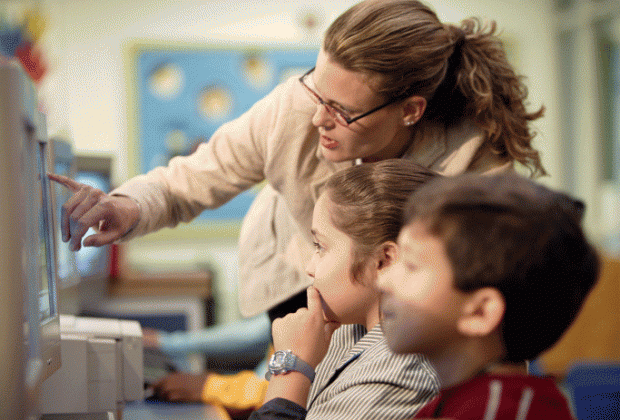
When computers first burst into the classroom back in the late eighties and nineties, most teachers were nonplussed by a new technology they had hardly been aware of, much less trained for. They stared at these new machines and wondered what were they supposed to do with them. A lifetime of teaching couldn’t provide them with a clue and what they were hearing from their administrators only added to the confusion. As a result some retired rather than deal with the newfangled things and some simply set them on their desks and ignored them.
The majority, thankfully, buckled down and decided to find out how these things worked and how they could be made to serve their students. Of course one of the first things they discovered was that the students either already knew how to use the darn things or were capable of learning to use them faster than their teachers … and teachers are still playing catch up with their students with each new technological arrival.
- 0 Comments
- Jul 17, 2014 2:00:00 PM
- Posted by Charles Nimrad
- Topics: EdTech, Education, 21st Century Classroom
Relevant Posts
Popular Posts
Subscribe to Email Updates
-
I Want To Learn MoreADDITIONAL INFORMATION


